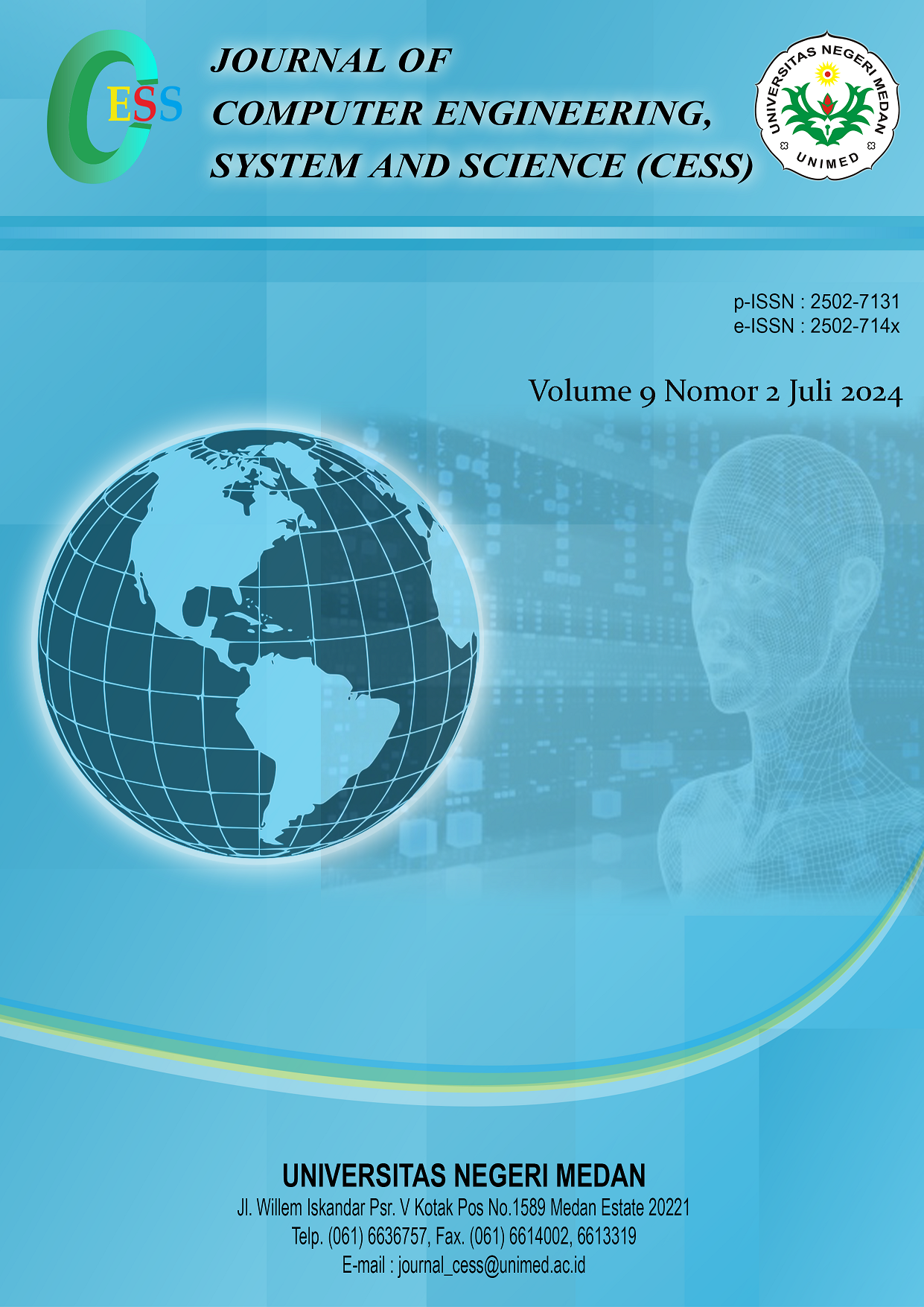Komparasi Performa VGG19, ResNet50, DenseNet121 dan MobileNetV2 Dalam Mendeteksi Gambar Deepfake
DOI:
https://doi.org/10.24114/cess.v9i2.58671Keywords:
Convolutional Neural Network, deepfake, klasifikasi gambar, VGG19, ResNet50, DenseNet121, MobileNetV2Abstract
Deepfake secara pesat menjadi potensi ancaman keamanan siber yang dapat memanipulasi gambar, video, bahkan audio dengan sangat realistis sehingga manusia mengalami kesulitan dalam membedakan apakah sebuah media adalah asli atau merupakan hasil manipulasi kecerdasan buatan. CNN menjadi salah satu metode yang dikembangkan sebagai solusi. Banyaknya varian model CNN membuka potensi untuk pengembangan lebih lanjut. Penulis mengumpulkan dari berbagai sumber 1,000 citra wajah asli dan 1,000 citra wajah deepfake yang kemudian diperluas dengan teknik augmentasi data untuk melatih, memvalidasi, dan menguji empat varian model CNN yaitu VGG19, ResNet50, DenseNet121, dan MobileNetV2, dengan tujuan untuk menentukan varian yang paling efektif sebagai basis model yang dapat dikembangkan menjadi detektor deepfake. Evaluasi dan perbandingan performa dengan teknik confusion matrix menunjukkan bahwa di antara keempat model, ResNet50 memiliki performa terbaik dengan akurasi 91,5%, presisi 90%, dan recall 91,3%.References
Whittaker, L., Mulcahy, R., Letheren, K., Kietzmann, J., & Russel-Benner, R. (2023). Mapping the deepfake landscape for innovation: A multidisciplinary systematic review and future research agenda. Technovation, 125.
Bray, S. D., Johnson, S. D., & Kleinberg, B. (2023c). Testing human ability to detect ˜deepfake™ images of human faces. Journal of Cybersecurity, 9(1), tyad011. https://doi.org/10.1093/cybsec/tyad011
Diakopoulos, N., & Johnson, D. (2021b). Anticipating and addressing the ethical implications of deepfakes in the context of elections. New Media & Society, 23(7), 2072“2098. https://doi.org/10.1177/1461444820925811
Gunawan, I. J., & Janisriwati, S. (2023b). Legal Analysis on the Use of Deepfake Technology: Threats to Indonesian Banking Institutions. Law and Justice, 8(2), 192“210. https://doi.org/10.23917/laj.v8i2.2513
Akbari, R. N., & Fithry, A. (2024b). MENGANALISIS PENGARUH HAK CIPTA DALAM GANGGUAN AI PADA SEKTOR MEDIA. Prosiding SNAPP : Sosial Humaniora, Pertanian, Kesehatan dan Teknologi, 2(1), 377“383. https://doi.org/10.24929/snapp.v2i1.3159
Groh, M., Epstein, Z., Firestone, C., & Picard, R. (2022b). Deepfake detection by human crowds, machines, and machine-informed crowds. Proceedings of the National Academy of Sciences, 119(1), e2110013119. https://doi.org/10.1073/pnas.2110013119
Kas, S., Hes, T., Jansen, B., & Post, R. (n.d.-b). Do you know if I™m real? An experiment to benchmark human recognition of AI-generated faces.
Salman, F. M., & Abu-Naser, S. S. (2022b). Classification of Real and Fake Human Faces Using Deep Learning. 6(3).
St, S., Ayoobkhan, M. U. A., V, K. K., Bacanin, N., K, V., Štěpán, H., & Pavel, T. (2022b). Deep learning model for deep fake face recognition and detection. PeerJ Computer Science, 8, e881. https://doi.org/10.7717/peerj-cs.881
Mu, J., Adrezo, M., & Haikal, A. N. (2024b). Identifikasi Wajah Asli dan Buatan Deepfake Menggunakan Metode Convolutional Neural Network. Teknika, 13(1), 45“50. https://doi.org/10.34148/teknika.v13i1.705
Bachri, C. M., & Gunawan, W. (2024). Deteksi Email Spam menggunakan Algoritma Convolutional Neural Network (CNN). 10(1).
Mianah, A. N., Diah Arie Widhining K, & Farrady Alif Fiolana. (2023b). Klasifikasi Helm Keselamatan Mengunakan Metode Convolutional Neural Network (CNN). JOURNAL ZETROEM, 5(2), 94“102. https://doi.org/10.36526/ztr.v5i2.2765
Bariyah, T., Rasyidi, M. A., & Ngatini, N. (2021b). Convolutional Neural Network untuk Metode Klasifikasi Multi-Label pada Motif Batik. Techno.Com, 20(1), 155“165. https://doi.org/10.33633/tc.v20i1.4224
Shad, H. S., Rizvee, Md. M., Roza, N. T., Hoq, S. M. A., Monirujjaman Khan, M., Singh, A., Zaguia, A., & Bourouis, S. (2021b). Comparative Analysis of Deepfake Image Detection Method Using Convolutional Neural Network. Computational Intelligence and Neuroscience, 2021, 1“18. https://doi.org/10.1155/2021/3111676
Chang, X., Wu, J., Yang, T., & Feng, G. (2020b). DeepFake Face Image Detection based on Improved VGG Convolutional Neural Network. 2020 39th Chinese Control Conference (CCC), 7252“7256. https://doi.org/10.23919/CCC50068.2020.9189596
Raza, A., Munir, K., & Almutairi, M. (2022b). A Novel Deep Learning Approach for Deepfake Image Detection. Applied Sciences, 12(19), 9820. https://doi.org/10.3390/app12199820
Patel, Y., Tanwar, S., Bhattacharya, P., Gupta, R., Alsuwian, T., Davidson, I. E., & Mazibuko, T. F. (2023b). An Improved Dense CNN Architecture for Deepfake Image Detection. IEEE Access, 11, 22081“22095. https://doi.org/10.1109/ACCESS.2023.3251417
Zhang, D., Li, C., Lin, F., Zeng, D., & Ge, S. (2021b). Detecting Deepfake Videos with Temporal Dropout 3DCNN. Proceedings of the Thirtieth International Joint Conference on Artificial Intelligence, 1288“1294. https://doi.org/10.24963/ijcai.2021/178
Kohli, A., & Gupta, A. (2021b). Detecting DeepFake, FaceSwap and Face2Face facial forgeries using frequency CNN. Multimedia Tools and Applications, 80(12), 18461“18478. https://doi.org/10.1007/s11042-020-10420-8
Abidin, M. I., Nurtanio, I., & Achmad, A. (2022b). Deepfake Detection in Videos Using Long Short-Term Memory and CNN ResNext. ILKOM Jurnal Ilmiah, 14(3), 178“185. https://doi.org/10.33096/ilkom.v14i3.1254.178-185
Guarnera, L., Giudice, O., & Battiato, S. (2020b). Fighting Deepfake by Exposing the Convolutional Traces on Images. IEEE Access, 8, 165085“165098. https://doi.org/10.1109/ACCESS.2020.3023037
Liu, J., Zhu, K., Lu, W., Luo, X., & Zhao, X. (2021b). A lightweight 3D convolutional neural network for deepfake detection. International Journal of Intelligent Systems, 36(9), 4990“5004. https://doi.org/10.1002/int.22499
Downloads
Published
Issue
Section
License
Copyright (c) 2024 CESS (Journal of Computer Engineering, System and Science)

This work is licensed under a Creative Commons Attribution 4.0 International License.










